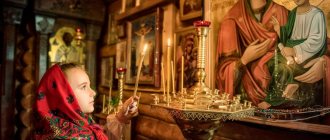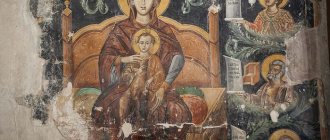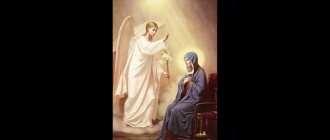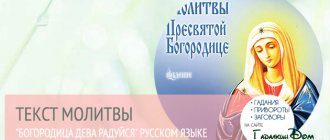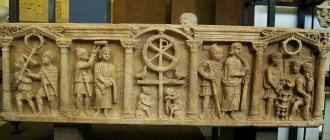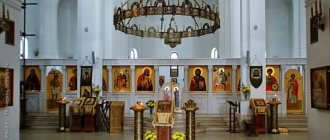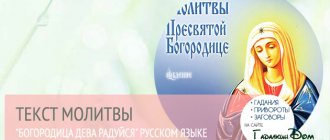Akathist icon of the Mother of God
Among the miraculous icons of the Mother of God there is a shrine that is of special importance. According to legend, the Akathist icon came out from under the hand of the Evangelist Luke and has exceptional divine power.
The Akathist Icon is the oldest shrine. There are several types of icons called Akathist. On January 25, the celebration takes place according to the icon, which is called Hilendarskaya. During the fire, when the iconostasis caught fire, the icon remained unharmed. An akathist was read over it, so it received the name of the same name. This icon served as a prototype for painting the image of “O All-Singing Mother,” or “Quick to Hear.” This image was named so for its quick help after sincere prayers addressed to it. The third well-known image is an icon depicting the reign of the Virgin Mary. Words from the akathist are written on it, glorifying the Mother of God bearing the immaculately conceived Divine Child.
History and description of the Akathist icon
The Akathist Icon of the Mother of God was painted using wax mastic, so the image has undergone changes over time. Its size is small, but its value is very high. The exact time when the icon was painted is unknown, but information about the shrine appeared already in 1274, when it was on Mount Athos.
The shrine disappeared many times, but each time miraculously returned to the temple. After being kidnapped by pirates in 1592, the Mother of God appeared in a dream to the captain and ordered the return of the holy face. After a sudden storm, the icon was returned to the monastery.
The icon depicts the Mother of God sitting on a throne with the Child in her arms. In terms of iconographic type, this is the “Tenderness” icon. The Divine Infant is depicted to the left of the Virgin Mary, who blesses the believers with her right hand and holds a scroll with Scripture in her left. On other lists, the Mother of God is depicted sitting on a throne without the Child.
Where is the Akathist image of the Mother of God located?
The Akathist Icon of the Mother of God is located on the island of Athos. There are lists from it in many temples and churches in Russia. They can be found in large cities: Moscow, St. Petersburg, Volgograd, Krasnoyarsk. There are also icons of the Mother of God in churches in the cities of Vladimir, Kostroma, and Ulyanovsk. You can venerate the shrine in most churches and temples.
How does the miraculous image of the Mother of God help?
Prayers are offered to the Mother of God in the hope of finding protection and patronage. They pray before her for protection from enemies, fires and other disasters. It is not for nothing that the image of the Akathist Mother of God is called the Quick to Hear. Sincere requests for help are always quickly fulfilled, and the Mother of God comes to the aid of believers in difficult times.
Prayer before the Akathist Icon of the Mother of God
“Wonderful and merciful Mother of God! We turn to You with sincere prayers. Hear the servants of God, do not turn away your gaze and grant us protection from any misfortune, help us to establish ourselves in the Orthodox faith and direct our good thoughts to God-pleasing deeds. Deliver, Mother of God, our houses and cities from enemy attacks, protect us from fires and natural disasters. Let us glorify the name of our Lord Almighty forever and ever. Amen".
Celebration date
The festive service takes place on January 25 (January 12, old style) . On this day, everyone can visit the church or pray to the Mother of God in front of the home iconostasis. The priests urge everyone to open their hearts and souls to the Higher Powers, to openly tell in prayer about their sins and ask for protection from the Mother of God.
Each prayer brings us closer to a righteous life and helps us cope with difficulties along the path of life. Do not deny yourself the opportunity to visit church to become imbued with holiness and honestly tell about your troubles in front of the icons. Requests for help will definitely be heard if they come from a pure heart, without self-interest or malicious intent.
Empty
- Seal
In the Dionysiatus Monastery on Holy Mount Athos there is a miraculous icon of the Blessed Virgin Mary, known as the Akathist ("Greeting of the Mother of God", "Praise of the Most Holy Theotokos" or Myrrh-Streaming). The oldest miraculous icon on Mount Athos is included in the iconostasis of the left side chapel of the “Praise of the Most Holy Theotokos” of the cathedral church of the Dionysia monastery. According to ancient monastic tradition, this is one of the 70 icons painted by the Evangelist Luke. It is made not with paints, but with wax mastic; the facial features are blurred due to the expiration of the world. Its dimensions are small: 33 cm high and 27.5 cm wide.
This icon was held in the hands of the Patriarch of Constantinople Sergius I, walking around the walls of Constantinople besieged by the Avars (624). Through the intercession of the Most Holy Theotokos, the enemy fleet was scattered by a storm, and the city was saved. The Akathist to the Most Holy Theotokos was performed for the first time in front of this icon.
Also, during the liberation of Constantinople from the crusaders, the Akathist Icon preceded the troops of Emperor Michael VIII Palaiologos. The icon was presented to the monastery by Emperor Alexei III of Trebizond (1337-1390) in honor of its founding.
Many miracles are associated with the Akathist Icon. Kidnapped by pirates (1592), she was returned by them to Dionysiatus after the Most Holy Theotokos appeared on the high seas to the captain of a ship and said menacingly: “Why did you put me in prison, you wicked man? Take Me to My dwelling!” The pirate did not pay attention to the dream and continued on his way. Suddenly a terrible storm arose at sea, threatening the destruction of the ship. Then the pirate remembered the icon, rushed to the box where it was, and, to his horror, saw it broken into several parts, and the holy icon all drenched in myrrh. The pirate took the icon in his hands, and the storm immediately stopped. Then the pirates hastened to return to the monastery, gave the icon to the monks and told about the former miracle. 2 pirates (according to other sources there were more) repented and became monks.
Another miracle happened to the head of the Athos Academy, the famous church and public figure of the 18th century, Eugene Voulgaris. He described in detail his healing from a tumor in his chest in 1758 from this icon.
In 1767, the Akathist Icon was stolen again, this time by Turkish robbers. They were detained by Greek shepherds and transferred the icon to the island of Skopelos.
Local residents did not want to return the icon to the monastery, for which they were subsequently punished. The island, which opposed the will of the Queen of Heaven, was struck by an ulcer, and the inhabitants themselves gave the icon to the Dionysiata monastery. In addition, as a sign of repentance, they donated land to the monastery on the island of Skopelos.
The Liturgy in the chapel where the Akathist Icon is located is served daily, and every evening before the Miraculous Icon the Akathist to the Most Holy Theotokos is read. On great holidays (Easter, Christmas, Epiphany and the Nativity of John the Baptist), the icon is transferred to the catholicon and placed in the icon case in front of the left column. The silver gilded robe, according to the inscription on it, was made by “Master George” in 1786 and donated to the monastery by “Bishop Jeremiah.” Its reverse side depicts the presentation of the icon to the Monk Dionysius by Emperor Alexios III Komnenos.
The celebration in honor of the Akathist Icon takes place on Saturday in the fifth week of Great Lent.
See also
Three miracles from the Three-Handed Icon of the Mother of God
On July 25, the Church celebrates the memory of the miraculous icon of the Mother of God “Three-Handed”, which is kept in the Vvedensky Church of the Serbian ancient Hilandar monastery on ...
Icon of the Virgin Mary of All Queens (Pantanassa)
The Vatopedi Monastery is a treasury of Orthodox shrines, among which the most famous are the Belt of the Most Holy Theotokos and Her icon, called “The All-Tsarina” (“Pantanassa”), to ...
Icon of Paramythia (Admonition, Vatopedi, Joy and Consolation)
Paramythia (January 21 / February 3) - in Greek. The Exhortation is one of the most revered images on Mount Athos...
Tikhvin Icon of the Mother of God (Tear-Drenched)
The icon received its name in connection with a miracle that happened on the eve of one of the bloody wars of the 19th century. The Tikhvin Icon of the Mother of God (Tear of Tears) is located ...
Xenophon Icon of the Mother of God “Hodegetria”
The Xenophon icon of the Mother of God “Hodegetria” was kept for centuries in the cathedral church of the Athos Vatopedi Monastery. In 1730, the shrine (despite ...
Icons of Athos: Hilendar Monastery, three miraculous images of the Blessed Virgin Mary
On January 12 (25 BC) in the Hilendar monastery on Holy Mount Athos they solemnly celebrate the memory of St. Sava of Serbia and ...
Icon of the Holy Great Martyr George
The Zograf Monastery, located near the sea pier, surrounded by tall spreading trees on the slope of a green hill, is dedicated to the Holy Great Martyr George. Among …
Icon of the Blessed Virgin Mary Koukouzelissa
The miraculous icon of the Mother of God, which more than once saved the Lavra of St. Athanasius, received its name in memory of the event that happened to the protopsalt...
Icon of the Great Martyr Panteleimon
In the Russian Panteleimon Monastery on Holy Mount Athos there is an icon of the great martyr and healer Panteleimon. His iconographic image is well known to everyone: ...
Icon of the Mother of God Merciful
The Icon of the Most Holy Theotokos “Merciful” is located in the Vatopedi Monastery in the chapel consecrated in honor of the Holy Great Martyr Demetrius. Its writing dates back to the 15th...
origin of name
Information about the origin of the name of the icon is uncertain; perhaps the name of the image reflects the memory of the reading of the Akathist to the Mother of God before it during the fire, also, according to the observation of Bishop. Porfiry (Uspensky), it can serve as an indication of the iconography of the compositions of the frame depicting scenes of the Akathist. A similar name, judging by the later inscription (on the field of the icon of the late 19th century, on the frame of 1875), was given to the icon of the Mother of God “Tenderness” from the Assumption Cathedral of the Moscow Kremlin (12th century. GMMC. Inv. 5154 coll. 55x42x5 cm): “ Akathist of the Holy Mother of God located [in] the Khil[ndar] monastery of Savva the Serbian,” however, the iconographic type reproduced on this icon is different than on the image from the Khilandar monastery.
Theotokos Akathist (copy) Akathist
Akathist to the Most Holy Theotokos before the Akathist icon
Kontakion 1
Chosen by the Eternal King for the salvation of the Christian race of Heaven and earth, to the Queen, as our undoubted Representative and all-powerful Intercessor, with love and tenderness we offer this akathist song: Rejoice, Most Holy Theotokos, who endlessly gives us spiritual joy.
Ikos 1
To the heavenly angel who became like a certain elder in his life, in the seclusion on the holy Mount Athos, conducting his life and before the icon of the Mother of God, every day an akathist singing with the words “Rejoice” ascending, there was sometimes a voice emanating from that icon: “Rejoice, you too, elder of God! " Hearing this wondrous voice, the pious elder and I sing to the Lady of Heaven: Rejoice, destined by God to be His Bride from the creation of the world. Rejoice, raised in His holy temple in unearthly purity. Rejoice, foretold by the prophets as the Savior of the world. Rejoice, thou who hast been worthy to become the Mother of God. Rejoice, having brought us the joy of deliverance from eternal death through the birth of Your Most Glorious Son. Rejoice, predestined to be the Mother of the entire Christian race by Your Son. Rejoice, Most Holy Theotokos, who endlessly gives us spiritual joy.
Kontakion 2
Seeing the Most Holy Theotokos, as if the elder was overcome with great horror, she said to him in a meek voice: Do not be afraid, otherwise, having flowed into your monastery, announce to the brethren and the abbot about those who are close to you. If anyone is weak in the spirit of patience, let him hide until the temptation passes, but let those who seek the crowns of suffering remain and, having received a reward from the Lord, sing to Him in heaven: Alleluia.
Ikos 2
It is impossible for the elder to comprehend with his mind that the icon of the Most Holy Theotokos, in front of her he is an akathist in the cell reading, was quickly transferred by an unknown force to the gates of the monastery. Having fallen before the image with reverent prayer, the elder also appeared with the most pure image in his arms to the abbot, chanting to the Pure Virgin: Rejoice, protecting Your children from the invasion of the enemy. Rejoice, Thou who tirelessly bestows Thy mercy upon them. Rejoice, you who lead us away from the destruction of our eternal soul. Rejoice, you who prevent great troubles with your strong hand. Rejoice, you who constantly care for our salvation. Rejoice, you who lead righteous souls to the heavenly kingdom. Rejoice, Most Holy Theotokos, who endlessly gives us spiritual joy.
Kontakion 3
Strengthened by the power from above and flowing with faith to Your all-merciful intercession, our irresistible Protectress, twenty-six strong-spirited monks, including the abbot himself, remained in the monastery. The elder, who received a heavenly revelation, was also with them, being for them a comforter in the upcoming temptation, tirelessly crying out to God: Alleluia.
Ikos 3
Having the intention of converting Orthodox Christians to Catholicism, they came to the monastery and came to the tower, while courageous monks stayed in it, approached, and tried to persuade them to renounce Orthodoxy with flattering admonitions. Exhorting them to recognize the pope as the head of the universal church, the Latins promised all mercy for this champion of Orthodoxy. Both the faithful sons of their Orthodox Church remained adamant and prayed before the icon of the Mother of God: Rejoice, our undoubted Protection from the Latins. Rejoice, in the Orthodox faith is our irresistible Strength. Rejoice, our strong protection from heresies and false teachings. Rejoice, our sweet Consolation in grave troubles. Rejoice, our wise Leader into the Kingdom of God. Rejoice, our merciful Intercessor before the Lord. Rejoice, Most Holy Theotokos, who endlessly gives us spiritual joy.
Kontakion 4
With a storm of hatred for the Orthodox faith, obsession, attack the tower with arrogance and wood and, without hesitation, set it on fire. In a fiery prayer, having given thanks to the Lord, as if I were worthy to receive martyrdom, the bright crowns, the foreigners offered to God: Alleluia.
Ikos 4
Hearing Your mercy, O Theotokos, through Your miraculous icon, You warned the elder about the disaster, returning to great joy, as Your icon was also found unharmed under the ruins of the monastery. We, marveling at such great mercy of Yours, cry out to You: Rejoice, for once again You appeared in Your icon to the joy of people. Rejoice, for with that icon you have wrought great miracles. Rejoice, for through You we are strengthened in virtues. Rejoice, for we boast of Your intercession before the infidels. Rejoice, for we magnify You before the whole world. Rejoice, for we place our complete trust in You. Rejoice, Most Holy Theotokos, who endlessly gives us spiritual joy.
Kontakion 5
Your icon, the Ever-Virgin Mary, appeared like a more divine star, for the consolation and strengthening of the brethren of the Zograf monastery, and before it the lamp glows unquenchably. During the Liturgy, the monks proclaim an akathist chant before it, which is why it is called the “Akathist” event. And having recognized the power You showed in it, they offer a song of thanksgiving to God: Alleluia.
Ikos 5
Having shown great love for people, You, like a tender and caring Mother, showed another of Your icons called “Hilendarskaya”, which was in the Athos Hilendarskaya monastery, where Your icons “Mammal” and “Popish” reside. For such Your care for Your people, we praise You: Rejoice, Guide of pious ascetics to the Heavenly Kingdom. Rejoice, you who lead desert-loving monks to the Heavenly Jerusalem. Rejoice, thou who filled Mount Athos with fragrance. Rejoice, having shown Thy favor at the monastery of the Hilendars. Rejoice, who quickly heals mental and physical illnesses with Your icon. Rejoice, Thou who bestowed Thy icon as a pledge of Thy mercy. Rejoice, Most Holy Theotokos, who endlessly gives us spiritual joy.
Kontakion 6
The Church of Christ preaches Your miracles, Mother of God, especially because through Your icons You pour out streams of mercy and generosity to all those in need and in need of Your help. For this reason, in praise of Thee, we cry out to Thy Son and our God: Alleluia.
Ikos 6
Your icon has risen to us, Ever-Virgin, by a new miracle that has flowed from it, when, through the negligence of the ecclesiarch, the iconostasis, which was in the cathedral church and in it was Your miraculous icon, was kindled. And even though the entire iconostasis almost burned to ashes, your holy image, Mother of God, was not harmed by the fire, remaining unharmed to the consolation of the believers who sing to Ti: Rejoice, you who made your honorable icon unburnable into fire. Rejoice, thou who by the Divine power destroyed the fiery power. Rejoice, Thy wonder-working icons, who multiplied the stars in the land of Athos. Rejoice, you who have sanctified the whole world with Your icons. Rejoice, showing Your mercy to us through the outpouring of peace from Your icons. Rejoice, wonderfully shining with grace and glory of miracles. Rejoice, Most Holy Theotokos, who endlessly gives us spiritual joy.
Kontakion 7
Although the Lover of Mankind, Christ showed His love for people redeemed by His Honest Blood, giving to You, His Mother, the Christian race as protection and protection. Do not deprive us of Your warm intercession, who glorify Your most honorable name and worship Your miraculous image, calling Your Son: Alleluia.
Ikos 7
Reveal a new and wondrous miracle, Your Akathist Icon, Most Holy Theotokos, from it came a revelation to Saint Sava of Serbia about the treasure that was near his holy monastery. Having found this treasure, the elder improved the monastery, glorifying his wonderful Helper: Rejoice, who quickly helps in our needs. Rejoice, you who generously send funds for the improvement of monasteries. Rejoice, you who do not abandon the holy monasteries under Your care. Rejoice, you who always supply what is lacking in them. Rejoice, you who once again call the faithful to prayer. Rejoice, you who tirelessly help them strive in piety. Rejoice, Most Holy Theotokos, who endlessly gives us spiritual joy.
Kontakion 8
We see a strange miracle about You, Mother of God, for from Your miraculous icon You give quick help to the faithful. For this, the monks of the Hilendar monastery, magnifying Your Akathist icon and also the Quick to Hear, offer thanks to the Lord: Alleluia.
Ikos 8
Envelop the whole world in Your love, Ever-Virgin, in Your ever-worshipped icon flowing around the whole of heaven. For you, like Your Son, do not want the sinner to die, but rather turn and live for him. For such Your mercy, we appeal to You: Rejoice, temporarily punishing and eternally merciful. Rejoice, you who teach us true repentance. Rejoice, you who do not leave us in our earthly destiny. Rejoice, you who joyfully greet us in the heavenly abodes. Rejoice, thou who admonishes us with saving truth. Rejoice, you who preserve us from the path of destruction. Rejoice, Most Holy Theotokos, who endlessly gives us spiritual joy.
Kontakion 9
Giver of all mercies and generosity, our hearts silently praise You, Most Holy Theotokos. Become our Intercessor to Your Son on the day of the Last Judgment, remembering then the prayers of sinners and worthy to sing to God: Alleluia.
Ikos 9
The branches of multi-proclamation will not be able to worthily glorify Your sweet face, nor explain below the power of Your miracles for every benefit of man, but we sing praises to You: Rejoice, who reveals to us the mysteries of God's will. Rejoice, you who mercifully soften His righteous anger. Rejoice, you who enlighten us with the rays of your miracles. Rejoice, thou who covert widows and orphans with Thy veil. Rejoice, most luminous Divine beauty. Rejoice, God-wise kindness. Rejoice, Most Holy Theotokos, who endlessly gives us spiritual joy.
Kontakion 10
Seeking salvation, we resort to Your merciful intercession, Merciful Mother, and we honor Your miraculous icons with reverence and faith. Moreover, remembering Your countless miracles, we cry out to Almighty God: Alleluia.
Ikos 10
You are an insurmountable wall for all people, O Most Holy Virgin. You wipe away our tears, giving peace to our troubled souls. You do not abandon us in times of hard trials, strengthening our spiritual and physical strength with Your grace. For this reason, hear us calling Ti: Rejoice, you who do not leave us on earth. Rejoice, you extend a helping hand to all who call upon You. Rejoice, Who constantly helps You by calling the Mother of God. Rejoice, you who strengthen us in the troubles that come our way. Rejoice, for You show us everything is possible. Rejoice, you who show us the path to salvation. Rejoice, Most Holy Theotokos, who endlessly gives us spiritual joy.
Kontakion 11
We offer all-contrite singing before Thy icons to Thy servants, the Mother of God. Do not despise us, O All-Merciful Lady, but be kind to us, who with faith and reverence worship Your Divine image and praise Your Son with a divine song: Alleluia.
Ikos 11
With the bright rays of Your miracles, O Virgin Mother of God, you lightly enlighten our souls, snatching them away from the darkness of destruction. We lovingly honor Thee, as the Mother of the Son of God and the Christian race, crying out to Thee: Rejoice, for the Lord is with Thee and Thee with us. Rejoice, for You have extended Your Holy protection over us. Rejoice, for the Burning Bush remains incorruptible. Rejoice, for the Life-Giving Source quenches the thirst for eternal truth in people. Rejoice, for the unfading color of our souls fills with fragrance. Rejoice, for the Indestructible Wall protects us from the storms of life. Rejoice, Most Holy Theotokos, who endlessly gives us spiritual joy.
Kontakion 12
Do not take the Divine grace clearly abiding in Your miraculous icons from us, O Most Holy Virgin, for our sins and iniquities. Do not forsake us by Your wonderful intercession, and at the Last Judgment of Your Son, seek forgiveness from the Lord for us, so that in ineffable glory we will see Christ our God and sing to Him: Alleluia.
Ikos 12
Singing songs of praise and thanksgiving to You, All-Singing Virgin, we all praise You, as a steadfast intercessor for us sinners, and we worship You with love, praying for us before the Lord, we believe and hope that You will ask Him for salvation and eternal life, crying Ti sice: Rejoice, thou who united God and man. Rejoice, you who have arranged human salvation. Rejoice, adorning the flowers of the faithful virtues. Rejoice, covering them with Your robe with maternal love. Rejoice, thou who protectest thee of the same blood from domestic strife and enmity with peace. Rejoice, you who always help us with good intentions. Rejoice, Most Holy Theotokos, who endlessly gives us spiritual joy.
Kontakion 13
O All-Singing Mother, Heavenly Queen and Lady, Virgin Mother of God, having graciously accepted this akathist chant, deliver us from all misfortune, illness and sudden death, and like the Elder of God there is no time to “Rejoice!” You shouted, so shout to us: “Rejoice, you too, children of God!”, crying to Your Son and our God: Alleluia. Alleluia. Alleluia.
This kontakion is read three times. Then Ikos 1 and Kontakion 1.
Catalog of icons on the website PravIcon.com
Description of the Akathist Hilandar icon
Source: Disc “Orthodox Church Calendar 2011” from the publishing house of the Moscow Patriarchate [2011]
The Akathist Icon of the Mother of God is located in the iconostasis of the cathedral Church of the Presentation of the Virgin Mary of the Serbian Hilandar Monastery on Athos. Data on the appearance and history of the glorification of the image on the Holy Mountain have not been preserved. Tradition dates her stay on Mount Athos to the end of the 12th century, when Saint Sava of Serbia, by revelation from the icon, found treasures and completed the construction of the monastery. However, none of the editions of the life of the saint contains confirmation of this story. The only reliable message about the icon, recorded from the words of eyewitnesses, is the story of its miraculous salvation during a fire in the monastery in 1837. The iconographic type of the icon is “Tenderness”. According to some information, this is a Greek icon of the 16th century. well preserved. The Child is depicted to the left of the Mother with his right hand blessing and his left hand down, in which He holds a scroll. With her right hand, the Mother of God supports the Baby by the right shoulder. The icon is placed in a silver frame, probably Russian work of the 19th century, […]
Akathist Icon of Hilandar - description
Source: Website “Miracle-Working Icons of the Blessed Virgin Mary”, author - Valery Melnikov [2011]
There are several types of icons with the name “Akathist”. The icon, which is celebrated on January 25, is called the Hilendar icon. The following event is associated with this image. In 1837, due to the negligence of the ecclesiarch (the person who was in charge of the order of worship in the monastery), the iconostasis in the church of the Hilendar monastery on Mount Athos caught fire. Almost the entire iconostasis burned out from the fire, but the image of the Mother of God remained completely unharmed. After the miraculous rescue of the icon from the fire, an akathist to the Most Holy Theotokos was read before it. Since then, the image began to be called Akathist. It is interesting that the monks of the Hilendar monastery also call this icon the Quick to Hear, for the quick help of the Mother of God after a prayerful appeal to Her in front of this icon.
Description of the Akathist Icon of the Most Holy Theotokos of Hilandar
The Akathist Hilandar Icon of the Mother of God is located in the cathedral Church of the Entry of the Virgin Mary of the Serbian Hilandar Monastery on Mount Athos. Local Athonite legend dates the appearance of the icon in the monastery to the end of the 12th century and connects it with Saint Sava of Serbia, whom it helped to find treasures for which the construction of the monastery was completed. However, none of the lists of the saint’s life mention this icon. A possible indication of it is contained in the epilogue “Tales of Miracles from the Icon of the Mother of God of Three Hands,” where there is a list of miraculous monastic icons. It states: “The friend [icon] who showed gold to Saint Sava, is hidden in the earth.” According to eyewitnesses, the story of the miraculous rescue of the icon during a fire in the monastery in 1837 is recorded. According to Savva Hilandarets, the veneration of the icon began with this event. The icon belongs to the “Tenderness” iconographic type. The size of the icon without frame is 80 by 60 cm, with frame - 87 by 65 cm. According to Byzantine scholar A. M. Lidov, the Hilandar icon has[...]
Description of the Akathist Hilandar icon from the book by E. Poselyanin
Source: Book “E.
Villager. Our Lady. Description of Her earthly life and miraculous icons” [1914] The very name of this icon “Khilendar” already shows that it is located in the same Athos Hilendar monastery where the above-mentioned icons of the Mother of God are located: “Mammal” and “Pop”. In 1837, due to the carelessness of the ecclesiarch, the iconostasis in the main cathedral church, in which stood the miraculous Akathist icon, caught fire. And although the entire iconostasis almost burned to ashes, the holy image of the Mother of God did not suffer at all from the fire and, to the consolation of the believers, remained unharmed. Since an akathist was read in front of this icon during the fire, it received the name Akathist. Tradition connects the name of this icon with the story that St. Savva the Serbian, during the construction of his Hilendar monastery, when a need arose, received from this icon a revelation about a treasure that was located near the monastery he was building. They say that he actually later found this treasure and, thanks to it, accelerated the construction of the buildings necessary for the monastery. It is difficult to say how reliable this legend is, especially since [...]
Description of the Akathist Hilandar icon
Source: Handbook of a church clergyman, author - S. V. Bulgakov [1913]
Akathist Hilandar St. The icon is located in the Athos Khidandar monastery. In 1837, during the fire of the iconostasis, she miraculously remained unharmed. At this time, an akathist was read before her, hence its name.
Literature
- A brief description of the twenty monasteries located in the Holy Mount Athos. Thessaloniki, 1839. L. 4;
- A brief history of the Slavic-Serbian Hilandar Lavra on Mount Athos: 1. Foundation of the Lavra. 2. Sights of the Lavra. St. Petersburg, 1862. P. 15;
- A guide to Mount Athos and an index of its shrines and other attractions. St. Petersburg, 18673. P. 161;
- Panov G. Historical, chronological and iconographic description of 218 names and images of the Blessed Virgin Mary. St. Petersburg, 1871. P. 5–6;
- Porfiry (Uspensky), bishop. The first trip to Athos monasteries and monasteries in 1846. K., 1877. Part 2. Dept. 1. P. 17;
- The highest cover over Athos, or Tales of saints, miraculous ones who became famous in Athos, icons of the Mother of God and other saints. St. Petersburg, 1892. P. 57, ill.;
- Dmitry (Sambikin). Monthsword. Vol. 5. P. 116;
- Bukharev I. Miracle-working icons of the Blessed Virgin Mary: (Their history and images). M., 1901. S. 4–5;
- Tales about the earthly life of the Blessed Virgin Mary with an account of prophecies and transformations. M., 1904. P. 262;
- Glory to the Mother of God: Information about the miraculous and locally revered icons of the Mother of God. M., 1907. P. 227;
- Villager E. Mother of God. P. 119;
- Zonova O. V. Our Lady of Tenderness XII century. from the Assumption Cathedral of the Moscow Kremlin // DRI. M., 1972. S. 270–271;
- Painting of Ancient Rus' XI - beginning. XIII century: Mosaics. Frescoes. Icons / Comp. Salko N. B. L., 1982. Table. 192, 194;
- Shtavlanin-Ђorђeviћ Љ. Miracles of the Most Holy Theotokos Agapiya Krijanina and new miracles of the Mother of God of Trojeruchita of the Hilandar manastir // Archaeographic orders. Beograd, 1984–1985. Kњ. 6–7. pp. 289–290;
- Sava Hilandarats. History of the Hilandar manastir: Assumption on the 100th year of foundation. Beograd, 1997. P. 101.
Iconography
Iconographic type - “Tenderness”. According to the observations of A. M. Lidov (travel diaries 1996; unpublished), this is Greek. 16th century icon well preserved. The Child is depicted to the left of the Mother with his right hand blessing and his left hand down, in which He holds a scroll. With her right hand, the Mother of God supports the Baby by the right shoulder. The icon is enclosed in a silver frame, most likely Russian. works of the 19th century, and in a frame with picturesque images of 12 kontakia and 12 ikos of the Akathist of the Virgin Mary (17th century). On the frame there is an inscription: Our Lady of Konevskaya
. The size of the image in the salary is approx. 87×65 cm; no salary approx. 80×60 cm.
The icon is located in the local row of the iconostasis of the Vvedensky Cathedral (second from the temple image), to the right of the royal doors. In front of the icon there are 3 lamps and a large candle.
